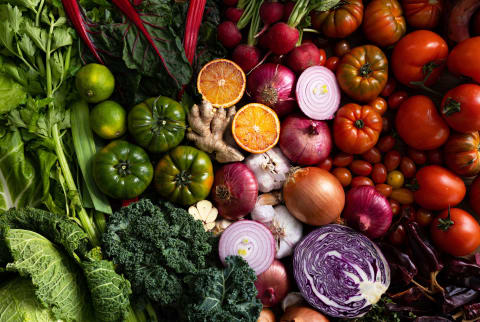Advertisement
Is Orange Food The Secret To Glowing, Bouncy Skin?


Sometimes the best nutrition advice is the simplest, especially when we're constantly inundated with diet tips, tricks, and so-called "perfect" methods. Generally, less is more: This applies to gut-friendly foods, hormone-balancing breakfasts, and even skin-loving dishes.
On that last point, here's one way to eat for brighter, healthier skin—without complicating your entire meal plan.
Why orange food is so great for the skin
One way to get more skin-boosting foods on your plate: Prioritize orange foods.
It may sound strange, but trust me, this makes "skin food" a whole lot easier to understand and a great starting point. See, orange foods like carrots and bell peppers contain carotenoids, like beta-carotene, which are A+ for skin health.
“The number of carotenoids in the skin has been shown1 to correlate with carotenoid intake,” explains registered dietitian Jessica Shapiro, M.S., R.D, CDN, CDCES. That said, it makes sense to incorporate these foods into your daily or weekly meal plans if possible. “Carotenoids provide skin protection with their antioxidant, anti-inflammatory, and light-absorbing properties,” she says.
In fact, one review study notes that a carotenoid-rich diet can even help protect the skin from UV damage, and therefore contribute to healthy skin aging. After all, 80% of visible signs of skin aging come from excess UV exposure2.
Other skin-related benefits include decreased erythema (or reddening of the skin)3, which is huge for those trying to brighten and even out their complexion.
Not to mention, adding more antioxidants to your diet is a great way to boost your skin’s resilience to environmental factors, like pollution, and even the impact of stress on the skin.
Plus, many of the carotenoid-rich foods also contain a hefty dose of vitamin C—which is essential for supporting your skin's natural collagen production4. Hence, why the classic vitamin-collagen pair is often found in skin supplement formulas.
Now, other non-orange foods also contain carotenoids, including some leafy greens. So while it may be easier to focus on one color, just know there’s a lengthy list of foods to experiment with—more below.
A carotenoid-rich grocery list
Here, a list of the best carotenoid-rich foods to add to your cart, from Shapiro:
"Don’t be surprised if your skin starts to have an orange or yellow glow (especially on your palms and soles of feet) when eating lots of carrots or other high carotenoid foods," Shapiro says—it's likely nothing to be concerned about, but we always seeing a professional if you notice anything concerning.
The takeaway
One way to prioritize skin-nourishing foods is by incorporating more carotenoid-rich staples in your diet, many of which have an orange or red hue. It's not essential, but it may help planning out your skin-healthy meals just a little bit easier. Now, this is just one component of eating for skin health—here's another list of essential foods for hydrated, supple skin.